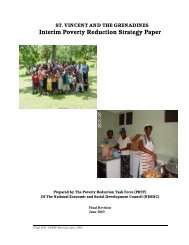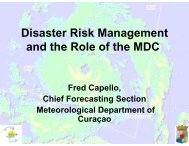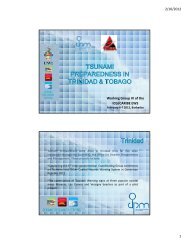The Anatomy of A Silent Crisis The Anatomy of A Silent Crisis
The Anatomy of A Silent Crisis The Anatomy of A Silent Crisis
The Anatomy of A Silent Crisis The Anatomy of A Silent Crisis
- TAGS
- anatomy
- www.bb.undp.org
You also want an ePaper? Increase the reach of your titles
YUMPU automatically turns print PDFs into web optimized ePapers that Google loves.
End notes<br />
109<br />
209. Greenpeace UK (2009) states that up to 75% <strong>of</strong><br />
Brazil’s emissions come solely from deforestation and<br />
according to MDG Statistics (2009), in 2004 Brazil<br />
emitted 1.22% <strong>of</strong> global carbon dioxide emissions.<br />
<strong>The</strong>refore, emissions from deforestation in Brazil<br />
equal approximately .92% <strong>of</strong> total emissions.<br />
210. Greenpeace UK (2009): “Deforestation and climate<br />
change.” Greenpeace UK. http://www.greenpeace.<br />
org.uk/forests/climate-change.<br />
211. Ramanatham, V. (2007): “Reduction <strong>of</strong> air pollution<br />
and global warming by cooking with renewable<br />
sources.” Project Surya, Scripps Institution <strong>of</strong><br />
Oceanography and Sri Ramachandra Medical College<br />
and Research Institute. http://www-ramanathan.<br />
ucsd.edu/Surya-WhitePaper.pdf and Rosenthal, E.<br />
(2009): “Third-world stove soot is target in climate<br />
fight.” <strong>The</strong> New York Times, April 15. http://www.<br />
nytimes.com/2009/04/16/science/earth/16degrees.<br />
html?_r=3&ref=world.<br />
212. Ramanatham’s research on Black Carbon is<br />
supported by Shindell and Faluvegi’s study published<br />
in March, 2009 in Nature Geoscience.<br />
213. Nelson, B. (2009): “Black carbon reductions could<br />
reverse Arctic warming within weeks.” EcoWorldly,<br />
April 9. http://ecoworldly.com/2009/04/09/blackcarbon-reductions-could-reverse-arctic-warmingwithin-weeks/.<br />
214. Milliken, M. (2009): “Water scarcity clouds<br />
California farming’s future.” Reuters, March 13.<br />
http://www.reuters.com/article/domesticNews/<br />
idUSTRE52C07R20090313?sp=true.<br />
215. Spotts, P. (2009): “California’s climate change<br />
bill could top $100 billion.” <strong>The</strong> Christian Science<br />
Monitor, March 11. http://features.csmonitor.com/<br />
environment/2009/03/11/california%E2%80%99sclimate-change-bill-could-top-100-billion/.<br />
216. Draper, R. (2009): “Australia’s dry run.” National<br />
Geographic Magazine, April.<br />
217. TWM. (2009): “ Drought Australia, 2003-09.” TWM.<br />
http://twm.co.nz/ausdrght.htm.<br />
218. Morrison, J. et al. (2009): “Water Scarcity & Climate<br />
Change: Growing Risks for Businesses and<br />
Investors.” Ceres and the Pacific Institute, p.6. http://<br />
www.ceres.org/Document.Doc?id=406.<br />
219. Mitchell, T. and van Aalst, M. (2008):<br />
“Convergence <strong>of</strong> Disaster Risk Reduction and<br />
Climate Change Adaptation.” DFID. http://<br />
www.research4development.info/PDF/Articles/<br />
Convergence_<strong>of</strong>_DRR_and_CCA.pdf.<br />
220. Watkins, K. (2007): “Human Develop Report<br />
2007/2008 Fighting climate change: Human solidarity<br />
in a divided world.” United Nations Development<br />
Programme. p191 speaks <strong>of</strong> US $8.4 billion in 2005.<br />
221. UNEP. (2004): “Extreme Weather Losses Soar<br />
to Record High for Insurance Industry.” UNEP,<br />
December 15. http://www.unep.org/Documents.<br />
Multilingual/Default.Print.asp?DocumentID=414&Articl<br />
eID=4682&l=en.<br />
222. Australian spending components include: US $2.8<br />
billion Natural Heritage Trust, US $1.3 billion National<br />
Action Plan for Salinity and Water Quality, and US $9<br />
billion National Plan for Water Security.<br />
223. Oxfam. (2007): “Financing adaptation: Why the UN’s<br />
Bali climate conference must mandate the search for<br />
new fund.” Oxfam International, December 9, p.6.<br />
224. Total funds currently available for Adaptation managed<br />
by the Global Environmental Facility: Strategic Priority<br />
on Adaptation (SPA) — (GEF Trust Fund: US $50<br />
million); Least Developed Countries’ Fund (LDCF)<br />
— (UNFCCC): US $172 million ; Special Climate<br />
Change Fund (SCCF) — (UNFCCC): US $90.3 million ;<br />
Adaptation Fund (Kyoto Protocol): US $80-300 million<br />
between 2008 and 2012, current funding estimated<br />
at US $91.3 million. South Centre. (2009): “Developed<br />
country finance initiatives weaken the UNFCCC”.<br />
http://www.southcentre.org/index.php?option=com_<br />
docman&task=cat_view&gid=45&Itemid=68.<br />
225. UNFCCC estimates 28 – US $67 billion in 2030; Oxfam<br />
estimates US $50 billion; World Bank estimates US<br />
$9-41 billion in developing countries today; Stern<br />
estimates US $4-37 billion in developing countries







